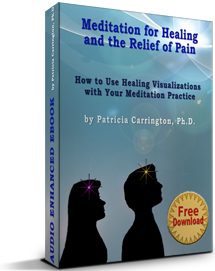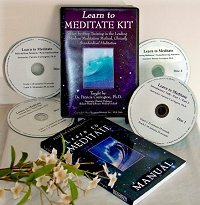Dr. Patricia Carrington's award winning meditation technique CSM (Clinically Standardized Meditation) is a clinically sensitive meditation method developed by the Medical Department of New York Telephone Company and used by numerous medical institutions, organizations, and individuals worldwide. For information .
Is Meditation a Unique State?
How is Meditation Different from Progressive Relaxation?
Patricia Carrington, Ph.D.
Author of “The Book of Meditation”
Psychophysiology studies the relationship between physical or chemical factors and behavior. In the mid-1930s psycho physiologist Dr. Edmund Jacobson developed a method for combating tension and anxiety which involved an interesting notion. He reasoned that since anxiety (as he had demonstrated in his laboratory) involves muscular tension, then turning the situation around and eliminating tension in the muscles should remove anxiety.1
To reduce muscular tension turned out to be not so easy, however. People who are chronically tense often have no awareness of the fact that they are tensing their muscles or in which part of the body they are doing so. Perhaps if they were to be made aware of the process of tensing various muscle groups they would gain control over the tensing-relaxing process? What Jacobson had hit upon was a rudimentary form of ‘biofeedback’, the process of becoming aware of bodily processes and bodily controls.
On the basis of his theory, Jacobson commenced to teach patients to ‘feel the tension’ in various muscle groups, one at a time. They were asked to tighten their muscles deliberately in each area of the body and were then directed to let the muscles relax suddenly and pay close attention to how this felt. Through this method Jacobson’s patients were eventually able to eliminate almost all muscle contractions and experience a feeling of deep relaxation.
Jacobson’s training, which he named ‘progressive relaxation’, was long and arduous. It required a total of fifty-six one hour training sessions to learn his basic technique, and further sessions were often desirable. This made his method too cumbersome for most research purposes, although it was undeniably effective, as Jacobson was able to prove over a long series of careful laboratory studies.2
In order to overcome this time drawback, behavioral psychologist Dr. Joseph Wolpe later modified Jacobson’s technique. In the new version, tensing and relaxing of the muscles were done much more rapidly and the training course was reduced to a total of six twenty-minute sessions.3 Like many other quick methods, this shortened version lost some of the strength of the original. Jacobson cautions against having the trainee tense and relax his muscles more than two or three times each hour, because this can result in too much effort being expended and might counteract relaxation. Wolpe and his followers ask their subjects to tense and relax their muscles repeatedly during each twenty-minute period. It is important to realize this, because Wolpe’s modification of Jacobson’s technique is the one widely used today. When we speak about a high drop-out rate from progressive relaxation, it will be well to remember that the Wolpe modification calls for real effort. Not too many people may be up to expending that kind of effort twice a day.
Are there similarities between progressive relaxation and meditation? Aside from the fact that they both bring about relaxation, progressive relaxation also calls for the atmosphere which is by now familiar to us in all the relaxation techniques – the quiet room, dim lighting, a comfortable position, and an easy, receptive attitude. But despite these points in common, there are important differences between this form of relaxation and meditation.
Wolpe’s therapists often use goal-directed suggestion and even hypnotic procedures to bring about awareness of bodily sensations when teaching progressive relaxation. Directions such as the following are typical: ‘Completely and totally relax . . . just let your muscles go. . . . Enjoy the feeling of deep relaxation. . . . Relax more and more. . . . Focus your attention on how it feels to have your muscles completely and totally relaxed . . .’ 4
Such phrases, repeated over and over again to the trainee in a soothing voice, are often mentally rehearsed by trainees when they practice this technique at home. Subjects also typically repeat muscle-tensing and relaxing commands to themselves when practicing progressive relaxation. This makes the technique a much more active one than meditation, with the exception of certain inevitable moments (longer or shorter according to the specific directions) when the practitioner remains entirely still.
In a study at Princeton University we compared progressive relaxers with meditators and found out something interesting about these ‘silent’ periods which the progressive relaxers experienced. During the ten minutes that our subjects spent lying still and relaxed after completing their muscle-tensing, about 65 percent of them reported that during at least a portion of this time they usually experienced states of mind which were unfocused, floating, passive and filled with shifting imagery. It seems as though they may have been entering a meditative mood during these still moments, a point to remember when we look upon the two techniques as distinct and then wonder why sometimes they have quite similar effects.
1. E. Jacobson, You Must Relax (New York: McGraw, 1934).
2. E. Jacobson, Progressive Relaxation (Chicago: University of Chicago Press, 1938); Modern Treatment of Tense Patients (Springfield, III.: C. C. Thomas, 1970); Biology of Emotions (Springfield, IU.: C. C. Thomas, 1967); Tension in Medicine (Springfield, III.: C. C. Thomas, 1967).
3. J. Wolpe, Psychotherapy by Reciprocal Inhibition (Stanford: Stanford University Press, 1958).
4. D. A. Bernstein and T. D. Borkovec, excerpt from Progressive Relaxation Training Record (Champaign, III.: Research Press, 1973).

